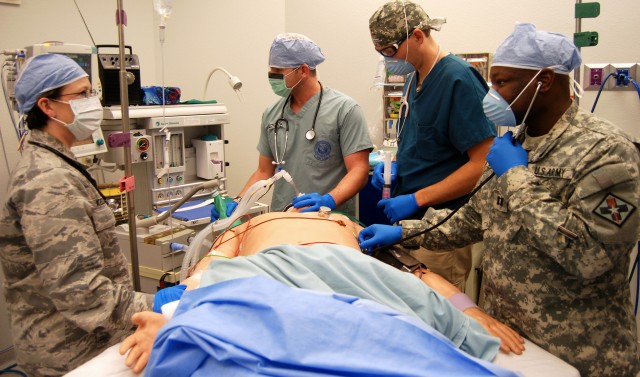
FORT SAM HOUSTON, Texas -- A recent annual U.S.News and World Report magazine ranking of the nation's graduate schools ranked the Army Medical Department Center & School's anesthesia nursing master's degree program as the best in the nation.
The Army graduate program in Anesthesia Nursing is affiliated with Northeastern University and ranked No. 1 in the nation among 112 accredited anesthesia nursing programs.
The Army-Baylor University doctoral program in physical therapy ranked fifth in the nation among 228 accredited doctoral programs.
The Army-Baylor University graduate program in Health and Business Administration ranked 11th in the nation among 90 accredited graduate programs.
The Interservice Physician Assistant master's degree program that is affiliated with Nebraska University ranked 13th in the nation.
U.S.News and World Report analyzed more than 1,200 graduate programs and the rankings are based on evaluations of curriculum, record of scholarship, quality of faculty and quality of students.
"We're not unique or special ... but our mission is," said Col. Josef Moore, dean of the graduate school. "The level of scholarship and leadership exhibited by not only the ranked programs, but all of our graduate programs, far exceed mission standards and take a back seat to no programs in the country.
"Grounded by the roots of our AMEDD heritage, now joined by our interservice colleagues, we are the tip of the spear nationally in graduate education," Moore added.
Accoring to the U.S.News and World Report website (http://www.usnews.com/education/best-graduate-schools/articles/2011/03/14/medical-school-rankings-methodology-2012), the medical school research model is based on a weighted average of eight indicators, and the primary-care model is based on seven indicators. Both rankings are based on a weighted average of indicators.
Four of the data indicators are used in both the research and primary-care ranking model.
They are the student selectivity admission statistics (MCAT, GPA, and acceptance rate) and faculty-to-student ratio. The medical school research model factors in research activity; the medical school primary-care model adds a measure of the proportion of graduates entering primary-care specialties.
The Academy of Health Sciences Graduate School hosts seven doctoral and five master's degree programs partnered with universities to support the graduate programs.
Academic affiliations include Baylor University, University of Nebraska Medical Center, Northeastern University, Fayetteville State University and Erskine Theological Seminary.
Students earn master's degrees in health and business administration, nutrition, anesthesia nursing, physician assistant studies and social work. Doctoral degrees include physical therapy, occupational therapy, pastoral care, physician assistant in emergency medicine or clinical orthopedics, sports medicine-physical therapy and orthopedic and manual physical therapy.
The AMEDD Center & School is accredited by the Council on Occupational Education and all programs of instruction are reviewed by the American Council on Education.
All graduate programs requiring higher level academic accreditation from their respective professional organizations continue to exceed all national benchmarks.
The Academy of Health Sciences manages 14 teaching departments providing 315 programs of instruction to officers, enlisted and foreign students with a total staff and faculty of 1,860. The programs range from oneweek courses to doctoral and master's degrees.

Social Sharing